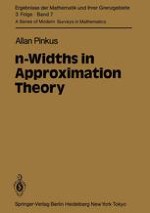My original introduction to this subject was through conservations, and ultimate ly joint work with C. A. Micchelli. I am grateful to him and to Profs. C. de Boor, E. W. Cheney, S. D. Fisher and A. A. Melkman who read various portions of the manuscript and whose suggestions were most helpful. Errors in accuracy and omissions are totally my responsibility. I would like to express my appreciation to the SERC of Great Britain and to the Department of Mathematics of the University of Lancaster for the year spent there during which large portions of the manuscript were written, and also to the European Research Office of the U.S. Army for its financial support of my research endeavors. Thanks are also due to Marion Marks who typed portions of the manuscript. Haifa, 1984 Allan Pinkus Table of Contents 1 Chapter I. Introduction . . . . . . . . Chapter II. Basic Properties of n-Widths . 9 1. Properties of d • • • • • • • • • • 9 n 15 2. Existence of Optimal Subspaces for d • n n 17 3. Properties of d • • • • • • 20 4. Properties of b • • • • • • n 5. Inequalities Between n-Widths 22 n 6. Duality Between d and d • • 27 n 7. n-Widths of Mappings of the Unit Ball 29 8. Some Relationships Between dn(T), dn(T) and bn(T) . 32 37 Notes and References . . . . . . . . . . . . . .
